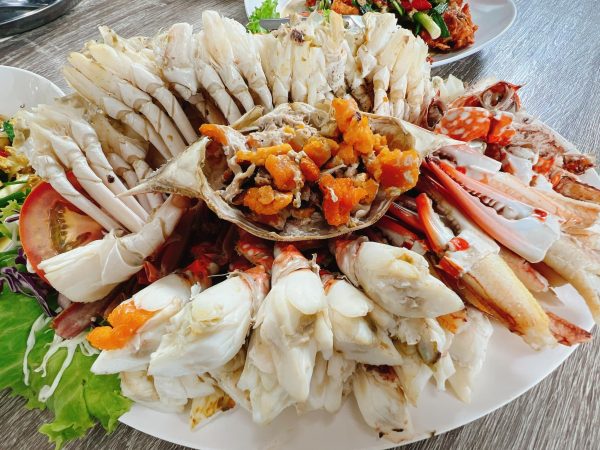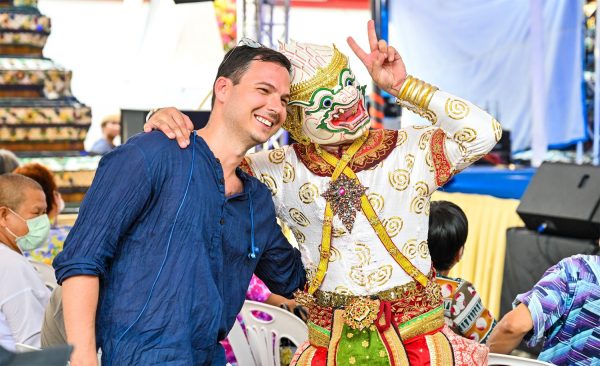The making of history

Glittering costumes, intriguing stories, stunning music, graceful dance, acrobatic movements, spectacular battle scenes and a myriad dazzling masks all make the masked dance drama known as Khon one of Thailand’s most-loved performing arts.
In 2018, UNESCO inscribed Khon on the Representative List of the Intangible Cultural Heritage of Humanity. To raise awareness of Khon as a national heritage, the Thai Khadi Research Institute of Thammasat University and the Department of Cultural Promotion are presenting “Khon Chan Kru” (Khon Masterpieces), an exhibition of Khon masks showing until December 20th at the Queen’s Gallery on Ratchadamnoen Klang Road.

The sumptuous exhibition showcases Khon masks specially made for females. One of the most distinguished of these is the Moon Plum mask, once worn by Kru Man or Manlee Kongprapat, a female Khon performer during the reign of King Rama VII. Kru Man later became a teacher at the School of Dance and Music, which is now called the College of Dramatic Arts. The gifted dancer also helped create Ram Mae Bot, a series of stylized dance patterns that is now a mandatory dance for all novice dancers.
Traditionally all characters in Khon were played by males, and all had to wear masks except the ones cast as female characters. Later, celestial beings and male characters discarded the masks and wore just the crown, called Chada or Mongkut. During the reign of King Rama IV of the Rattanakosin period, females were allowed to perform in Khon. Since then, some outstanding female performers have even taken on the male roles.

Records show that Khon has existed since the Ayutthaya period. It was also a significant performance during royal ceremonies and considered one of the Royal decorations of the King. The masked performance peaked in popularity in the early Rattanakosin era, experienced a downturn during the Great Depression and drastically dwindled after the 1932 Siamese Revolution.
Her Majesty Queen Sirikit, the Queen Mother, revived the Khon performance and emphasized the need to conserve Khon as Thailand’s national performing art. Wishing to raise awareness of Khon preservation and treasure it as a national heritage, the Queen Mother initiated the annual Royal Khon or “Khon Luang” for the public. For more than a decade, the SUPPORT Foundation of Her Majesty Queen Sirikit of Thailand has presented the annual Royal Khon masked dance complete with elaborate costumes, magnificent masks, special effects, and outstanding stage sets.
Khon depicts episodes from Thailand’s national epic Ramakien, which is derived from India’s Ramayana, playing out its spectacular battle scenes and intriguing plots. It is near impossible to distinguish a large number of characters on the stage, and that’s where the Khon mask plays an important role.

Each mask is a role-specific item that can generally be identified by its colours, patterns, decoration and facial expression. The masks can be classified into male (human and deity), demon and monkey. The face of the male character or Hua Khon Pra is oval-shaped with a calm and graceful look. The demon’s mask, Hua Khon Yak, is shaped like a palm fruit and gives off a powerful vibe with its intimidating look. The most difficult one to make is Hua Khon Ling or monkey mask because it should convey both a savage and playful vibe. Khon masks for demons and monkeys are divided into the Peaked Mask Demon (Yak Yod) for a high-ranking demon, the Bald Mask Demon (Yak Lon) for a low-ranking demon, the Peaked Mask Monkey (Ling Yod) for a high-ranking monkey, and the Bald Mask Monkey (Ling Lon) for a low-ranking monkey.
The Khon mask is a helmet-like mask made from papier-mâché with details crafted out of lacquer, paint, gold leaf, and glass mosaic. Some special masks are decorated with mother-of-pearl. Traditional Khon masks used Kradad Khoi, Streblus Asper paper, due to its durability. Today, Kradad Khoi has been replaced by Kradad Sa, or mulberry paper, which is easier to find. The colours of the masks, the ornamentations and the shapes of eyes and mouths all have specific meanings based on Thai myth and belief.

Traditionally, the art and science of mask-making is inherited within the artisan’s family. As a result, many techniques have been kept secret throughout the centuries and died out with time. Each family would create their unique technique, colour mixture and style to make their Khon masks more elaborate and standout from the rest.
In the “Khon Chan Kru” exhibition, visitors can appreciate the craftsmanship of Chit Kaewduangyai, one of the most gifted khon mask artisans of the Kaewduangyai family. Chit’s creativity and innovation are evident in every mask he made. Knowing that the performers had to move continuously during the performance, the master artist paid attention to every detail to make the masks as comfortable as possible for all performers. He focused on ventilation as well as all contact-points that would absorb sweat, which would inevitably shorten the life of the paper-based masks. Fortunately, his knowledge and techniques were not in vain since his children passed them on to students of The Royal Craftsmen School, established in 1989 by the Bureau of the Royal Household and the Ministry of Education.

This exhibition shows Khon mask development from the Rama I period to the present. The highlights are the unique masks designed for special characters like baby sea-ogre Sinsamut, deer head Kalaikot Rishi (Rishyasringa), boar-head deity Varaha, great vulture Sampati, female demon Sammanakkha, and the bear Chompu Mee. King Rama VI initiated the Chompu Mee mask for the scene that sees the monkey king Champuwaraja (Jambavana) transformed into a giant bear to destroy Indrajit’s ritual to empower the celestial weapon, the Nagabat arrow, in the Rotan Tree Hollow.
The various Rishi masks on show reflect the different beliefs held by traditional Thai dancers and actors. Traditional Khon uses the Rishi mask in the performance, but today, it is a sacred object representing ‘Phra Bharata,’ the Rishi who composed the treatise on the art of dancing. These days, the Rishi mask, the demon deity Phra Phirap mask,- and the elephant-head deity Kanesha mask are used in the Krob Kru ceremony to pay homage to masters and all deities involved in the Khon, traditional dance and music.
The 93 intricate khon masks in the exhibition are testament to the creativity skill, and the power of imagination of Thai artisans that have been passed down through the centuries. One can only hope that these incredible works of art will live on for centuries to come.
If you go
The Khon Mask Exhibition: Khon Chan Kru (Khon Masterpieces) runs from now until December 20th, 2020 on the fourth floor of The Queen’s Gallery (4th floor). It’s open daily except Wednesday from 10am to 7pm. Admission is Bt50. The gallery is on Ratchadamnoen Klang Road, Bangkok and parking is available. You can also take the MRT Blue Line to Sam Yot Station. The gallery is a 15-minute walk along the Mahachai Road or around five minutes on a public bus.






